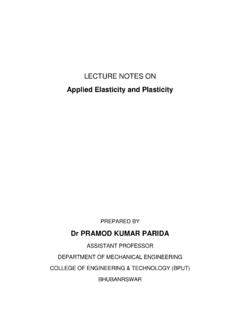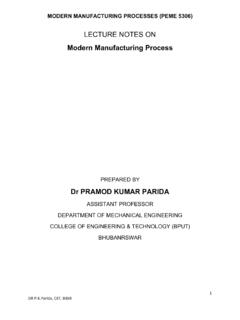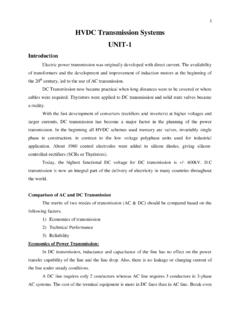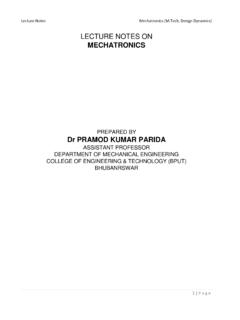Transcription of LECTURE NOTES ON
1 LECTURE NOTES ON. Rapid Prototyping PREPARED BY. Dr PRAMOD KUMAR PARIDA. ASSISTANT PROFESSOR. DEPARTMENT OF MECHANICAL ENGINEERING. COLLEGE OF ENGINEERING & TECHNOLOGY (BPUT). BHUBANRSWAR. Syllabus PEME5303 RAPID PROTOTYPING (3-0-0). Module I (12 hours). Product Development: Classification of manufacturing processes, Different manufacturing systems, Introduction to rapid Prototyping (RP), Need of RP in context to batch production, FMS and CIM and its application. Product prototyping solid modeling and prototype representation, reverse engineering, prototyping and manufacturing using CNC machining. Basic principles of RP steps in RP, process chain in RP in integrated CAD-CAM. environment, Advantages of RP. Module - II (12 hours). Rapid Manufacturing process Optimization: factors influencing accuracy. Data preparation errors, Part building errors, Error in finishing, influence of build orientation. Classification of different RP techniques based on raw materials, layering technique (2D or 3D) and energy sources.
2 process technology and comparative study of stereo lithography (SL) with photopolymerisation, SL with liquid thermal polymerization, solid foil polymerization, selective laser sintering, selective powder binding, Ballastic particle manufacturing . both 2D and 3D, Fused deposition modeling, Shape melting Module III (12 hours). Laminated object manufacturing solid ground curing, Repetitive masking and deposition. Beam interference solidification, Holographic interference solidification special topic on RP. using metallic alloys, Programming in RP modeling, Slicing, Internal Hatching, Surface skin films, support structure. Software for RP: STL files, Overview of Solid view, magics, imics, magic communicator, etc. Internet based software, Collaboration tools. Text Book : 1. Rapid Prototyping and Engineering Applications, Frank W. Liou, CRC Press 2. Introduction to Rapid Prototyping, Amitav Ghosh, North West Publication, New Delhi Reference Books : 1.
3 Rapid Manufacturing, Flham &Dinjoy Verlog London 2001. 2. Rapid Prototyping Materials, Gurumurthi, IISc Bangalore. 3. Rapid Automated, Lament wood. Indus press New York 4. Stereo Lithography and other RP & M Technologies, Paul F. Jacobs: SME, NY 1996. 5. Rapid Prototyping, Terry Wohlers Wohler's Report 2000" Wohler's Association 2000. Module I. Manufacturing The English word manufacture is several centuries old. The term manufacture comes from two Latin words, manus (hand) and factus (make). As per oxford English dictionary manufacture refers to make or produce goods in large quantities, using machinery . Working definition of manufacturing There are two types of working definitions available for manufacturing: as a technical process and as an economic process . Technologically: Manufacturing is the application of physical and chemical processes to alter the geometry, properties and or appearance of a given starting material to make parts or product as shown in Figure Definition of manufacturing in terms of technology Economically: Manufacturing is the transformation of materials into items of greater value by means of one or more process and or assembly operation as shown in Figures.
4 Definition of manufacturing in terms of economic value Diagrammatic representation of Manufacturing Factors Contributing to Production Growth Activities involved in Manufacturing Development and Progress of Manufacturing Classification of the Manufacturing process : The manufacturing process used in engineering industries basically perform one or more of the following functions: Change the physical properties of the work material Change the shape and size of the work piece. Produce desired dimensional accuracy and surface finish. Based on the nature of work involved these processes may be divided into following seven categories: 1. Processes for changing physical properties of the materials . Hardening, Tempering, Annealing, Surface Hardening. 2. Casting Processes Sand Casting, Permanent mold casting, die casting, Centrifugal casting 3. Primary metal working processes Rolling, forging, extrusion, wire drawing 4. Shearing and Forming processes Punching, blanking, drawing, bending, forming 5.
5 Joining processes Welding, brazing, soldering, joining 6. Machining Processes Turning, drilling, milling, grinding 7. Surface finishing processes Lapping, honing, superfinishing Spectrum of Manufacturing process MANUFACTURING SYSTEM. The term manufacturing system refers to a collection or arrangement of operations and processes used to make a desired product or component. It includes the actual equipment for composing the processes and the arrangement of those processes. In a manufacturing system, if there is a change or disturbance in the system, the systems would accommodate or adjust itself and continue to function efficiently. Normally the effect of disturbance must be counteracted by controllable inputs or the system itself. Figure below gives the general definition for any manufacturing system. General representation of Manufacturing system TYPES OF MANUFACTURING SYSTEMS. The manufacturing systems differ in structure or physical arrangement.
6 According to the physical arrangement, there are four kinds of classical manufacturing systems and two modern manufacturing systems that is rapidly gaining acceptance in industries. The classical systems are 1. Job shop 2. Flow shop 3. Project shop 4. Continuous process The modern manufacturing systems are 1. Linked cell system (Cellular manufacturing system). 2. Flexible manufacturing system (FMS). Job shops In a Job shop, varieties of products are manufactured in small lot sizes to a specific customer order. To perform a wide variety of manufacturing processes, general purpose production equipment is required. Workers must have relatively high skill levels to perform a range of different work arrangements. The production machines are grouped according to the general type of manufacturing processes as shown in Figure below. The lathes are in one department, drill presses in another and so on. Each different part requiring its own sequence of operations can be routed through the various departments in the proper order.
7 For this ROUTE SHEETS' are used. The layout made for this purpose is called as functional or process layout. Functional or process layout Advantages of process layouts Can handle a variety of processing requirements Not particularly vulnerable to equipment failures Equipment used is less costly Possible to use individual incentive plans Disadvantages of process layouts In- process inventory costs can be high Challenging routing and scheduling Equipment utilization rates are low Material handling is slow and inefficient Complexities often reduce span of supervision Special attention for each product or customer Accounting and purchasing are more involved Examples: Machine shops, foundries, press working shops, plastic, industries. Flow shops The flow shops have a product oriented layout composed mainly of flow lines. This system can have high production rates. The plant may be designed to produce the particular product or family, using Special purpose machines rather than general purpose equipment.
8 The skill level of the laborer tends to be lower than in production job shop. When the volume of production becomes large, it is called mass production . The material flow is through a sequence of operations by material handling devices. The time the item spends in each station or location is fixed and equal. The workstations are arranged in line according to the processing sequence needed as shown in Figure below Product layout Advantages of product layout High rate of output Low unit cost Labor specialization Low material handling cost High utilization of labor and equipment Established routing and scheduling Routing accounting and purchasing Disadvantages of product layout Creates dull, repetitive jobs Poorly skilled workers may not maintain equipment or quality of output Fairly inflexible to changes in volume Highly susceptible to shutdowns Needs preventive maintenance Individual incentive plans are impractical Example: Automated assembly line and Television manufacturing factory.
9 Project shop In this type, a product must remain in a fixed position or location because of its size and weight. The materials, machines and people in fabrication are brought to site. The layout is also called as fixed position layout. Figure below shows the project shop layout. Example: Locomotive manufacturing, large aircraft assembly and shipbuilding Project shop layout Advantages of project layout Minimum capital investment Continuity of operation Less total production cost. Offers greater flexibility Allows the change in production design. Permits a plant to elevate the skill of its operators Disadvantages of project layout Machines, tools and workers take more time to reach the fixed position. Highly skilled workers are required. Complicated jigs and fixtures (work holding device) may be required. Continuous process In this continuous process , the product seems to flow physically. This system is sometimes called as flow production when referring to the manufacture of either complex single parts, such as scanning operation, or assembled products such as TVs.
10 However, this is not a continuous process , but high volume flow lines. In continuous process , the products really do flow because they are liquids, gases, or powers. Figure shows the continuous process layout. It is the most efficient but least flexible kind of manufacturing system. It usually has the leanest and simplest production system because this manufacturing system is the easiest to control because it has the least work- in progress(WIP). Examples: Oil refineries, chemical process plants and food processing industries Continuous process layout Linked cell manufacturing system Cellular manufacturing (CM) is a hybrid system for linking the advantages of both job shops (flexibility in producing a wide variety of products) and flow lines (efficient flow and high production rate). A cellular manufacturing system (CMS) is composed of linked cells . Figure below shows the main structure of cellular manufacturing system. In cells, the workstations are arranged like a flow shop.










